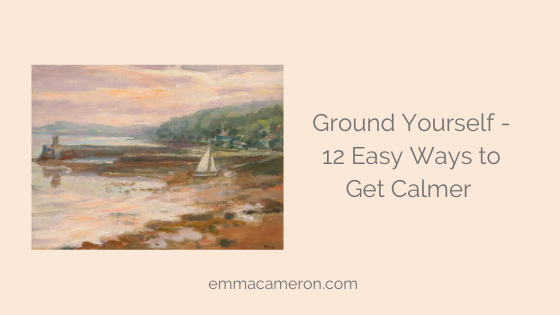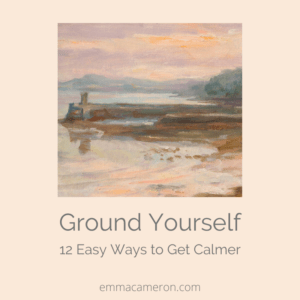
If you sometimes feel overwhelmed by strong emotions or body sensations like panic, fear, anger, sadness etc, it’s a good idea to know some easy ways to ground yourself. Getting grounded means that you don’t stay swept up in the intense feelings (hyperarousal), and also don’t zone out or numb yourself (hypoarousal).
Grounding yourself is one way of getting your emotional thermostat working again when things are getting too hot (or too icy). When the emotional temperature has risen too high (or dropped too low), grounding yourself can help you regulate it to a more comfortable level.
Grounding can be particularly helpful for people who are highly sensitive (HSP) or survivors of trauma. Grounding may also stave off a panic attack.
How to Know You Need to Ground Yourself
You may be very aware of when you’re starting to feel overwhelmed and need to get yourself grounded. On the other hand, sometimes we don’t realise it’s happening. So knowing the early warning signs can be useful.
Early Warning Signs
Here are some signs that you could be getting close to the edge of your nervous system’s ‘window of tolerance’. If you notice any of these, you may need to ground yourself so that you don’t tip over into overwhelm, panic or dissociation:
- Feeling flustered
- Sweating even though you’re not exercising
- Dry mouth
- Jiggling legs
- Eyes darting around
- Fast breathing
- Sudden headache
- Feeling dizzy, spacey or confused
- Stomach tightening
- Nausea
- Suddenly doing things very fast; or very slowly as if underwater
Ground Yourself Using Body and Mind
When an emotion gets too intense and overwhelming, we need to get our attention away from emotion, to some extent, and into either thoughts, or body sensations. You can experiment to see whether your own preference is for thoughts, or body-based awareness. A mixture of the two is ideal: for example, attending to body sensations in your feet and then finding words to describe what you notice.
12 ways to ground yourself so you get calmer quickly Share on XBody-Based Grounding Techniques to Calm You
1 Breathing
Rest your hand on your abdomen and slowly breathe down towards it. Your hand should gently move out as your belly does. Breathe out very slowly, pursing your lips as if you’re blowing through a narrow straw. Repeat a few times, noticing how it feels in your mouth, nose, chest, belly and hand.
2 Feel Your Feet
Moving your attention to your feet and legs can be very helpful in grounding yourself. Really try and focus on feeling your feet: what sensations can you notice? Once you’ve become aware of something — a tingling, ache, warm feeling, tension, or anything else — try to put it into words as if you were going to have to describe it exactly to someone.
3 Hand on Heart
This one is surprisingly powerful. Applying a gentle pressure, put one hand on your heart area. Or, you might place the hand slightly higher and more central — experiment with where feels best. Breathe slowly and deeply, imagining a comforting and soothing warmth (or light) flowing through your hand and around your heart.
4 Sensory Collection
Some people with PTSD find it very helpful to make up a little ’emergency toolkit’ of things that can help ground them and bring them back into their here-and-now body. The toolkit could be a little bag or box containing various things like strong mints, a bag of strong-smelling stuff like coffee beans or lavender, something with a texture (smooth velvet, silk, a squishy sensory toy or rough tree bark) and a photo of a much-loved person, place or pet.
5 Tree Roots
Standing with feet firmly planted on the ground, imagine yourself as a tree. Visualise roots growing from your feet, branching confidently and with vigour and strength deep down into the ground. Spend a full minute or longer getting an embodied sense of this. Read more here.
6 Arts and Crafts
Any activity that combines hand-movements and creativity can be very good for grounding. Choose from colouring, drawing patterns, knitting, sewing, carving, or any other craft or art activity that you find absorbing and grounding.
7 Movement
Getting your body moving in a rhythmic way can be helpful. Walking, jogging, dancing and yoga can all be helpful for getting grounded, particularly if you can do them with someone else. Tossing a ball with someone can also be very good for grounding.
8 Nature
Depending on the situation, connecting with nature is possibly the most effective grounding activity. Touching a tree, smelling flowers or the earth, breathing in fresh air, gazing at clouds, or looking at a landscape, garden or pond, can all have a powerful positive grounding effect. It’s even better if you’re in a position to take your shoes and socks off so you can feel the ground or grass with the soles of your feet.
12 ways to calm your anxiety using quick, simple grounding techniques Share on XThoughts-Based Grounding Techniques to Calm You
9 Naming Things Around You
Naming or labelling things can shift our attention away from our emotions, as a different part of the brain has to get working. Here are a few ideas: Name three things around you that are blue. Name every item of furniture you can see. List the clothes you are wearing, and then order them from oldest to newest.
10 Lists of Ten
Challenge yourself to list 10 farmyard animals, 10 countries in Europe, 10 rivers, 10 kitchen items, 10 colours, etc. This gets your thinking, problem-solving brain active.
11 Senses: Five, Four, Three, Two, One
Identify and name five things you can see; four things you can hear; three things you can touch; two things you can smell; and one thing you can taste.
12 Co-Regulation
Grounding can be done by yourself on your own. However, if there’s someone around who can help you feel calm and connected, co-regulation is ideal. Co-regulation is when a safe, trusted person stays present with you. They might talk reassuringly to you in a kind voice, giving you friendly eye contact. Check in with yourself to see if it would help the co-regulation process if they hold your hand or place their hand on your back. You can even co-regulate with a pet — cats, dogs and horses can all be good for this.
What Helps You Ground Yourself to Get Calmer?
What grounding techniques have you found most effective? I’d love to hear them – just leave a comment below!
And if you’re needing to ground yourself frequently, and sensing that you could benefit from a bit of additional help, consider contacting a psychotherapist, Art Therapist or counsellor. I work online with HSP’s (highly sensitive persons) and other thoughtful, creative people in the UK and abroad. Contact me espcameron[at]protonmail.com to book a free 15-minute phone consultation to see if I might be the right therapist for you.
Painting ©T. Spencer Pryse, 2019
